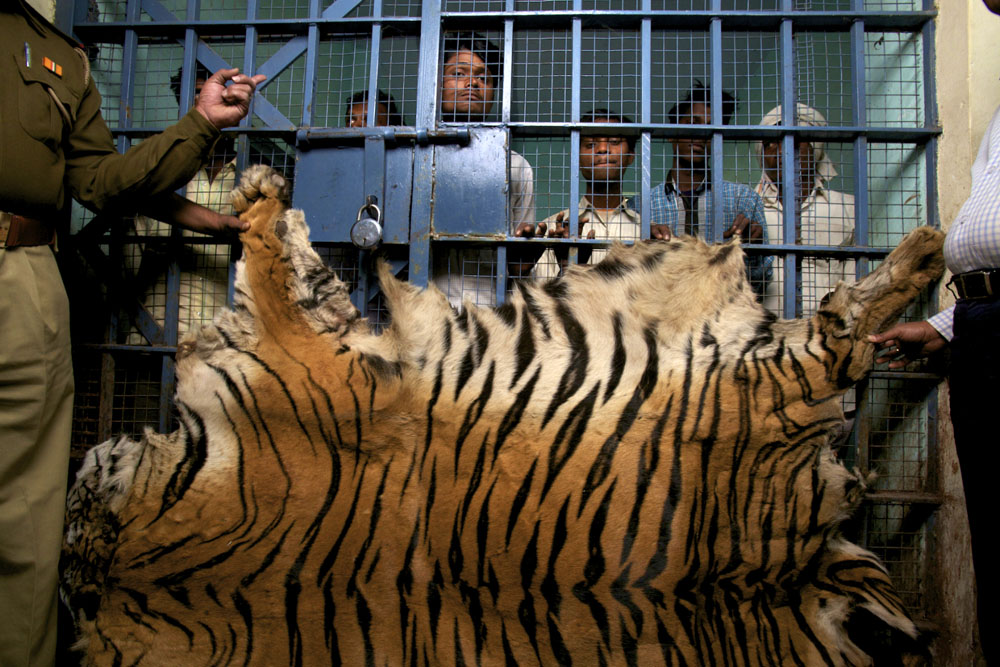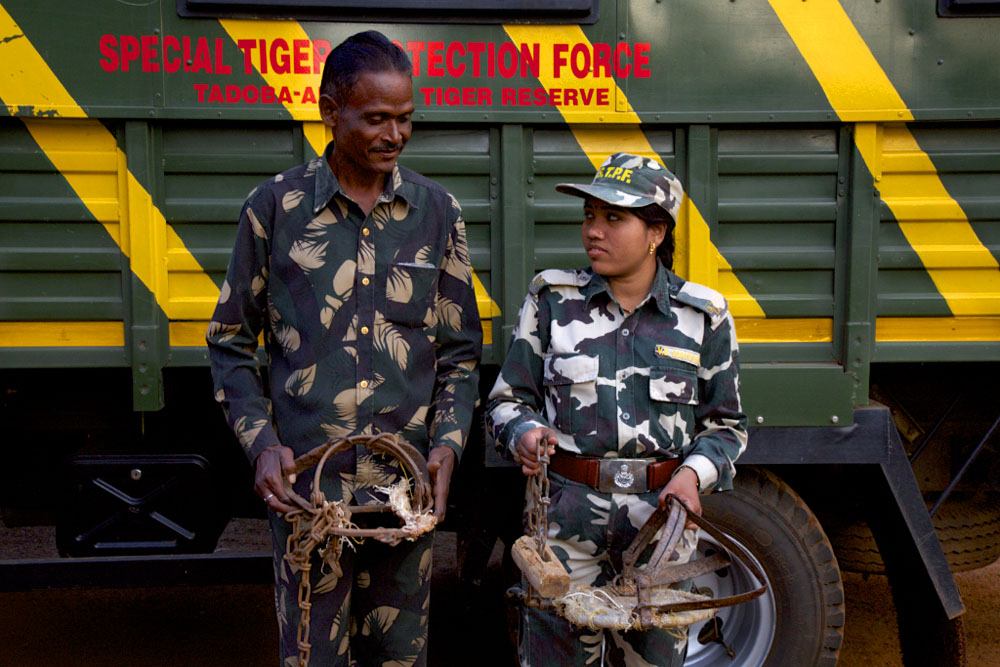-
As Asian Luxury Market Grows, a Surge in Tiger Killings in India
January 24, 2017 By Sharon GuynupFrom 1990 to 2013, the notorious tiger poacher Kuttu Bahelia and his extended family – brothers, uncles, and their wives and children – reportedly killed hundreds of tigers and leopards in the tiger-rich Indian states of Maharashtra and Karnataka, according to law enforcement informants and media reports. “Even if half that [estimate] is correct, it is still a very significant number,” says Belinda Wright, who directs the non-profit Wildlife Protection Society of India (WPSI).
So there was relief when, after years of eluding the police, Kuttu was arrested in 2015. He faced at least six counts of tiger poaching in forests across the central state of Maharashtra and was held without bail. On January 21, 2016, he was taken to court to stand trial in the first of those cases, for allegedly poaching a pair of tigers three years earlier. After his court appearance, while being transported back to jail, he begged to make a restroom stop – and fled into the forest, handcuffed, successfully evading his two police escorts.
Authorities launched a manhunt, but Kuttu – who is descended from a long line of traditional hunters – had vanished.
A Dark History
In 2016, tiger poaching in India surged to its highest levels in 15 years. The spike was the result of a deadly confluence of factors that included killings by roving gangs like Kuttu’s; more tigers snared by locals, who are increasingly trapping deer, wild boar, and other game for food; and cutbacks in anti-poaching patrols due to federal budget cuts.
There were 50 confirmed tiger poaching deaths last year, according to WPSI statistics. But the actual number may be much higher. Customs officials usually multiply known poaching offenses by 10 to estimate the true scope of the illegal trade. Another 82 tigers perished in 2016 from causes other than poaching, bringing the confirmed death toll to 132. Many tigers were killed to meet a thriving illicit demand, largely in China, for pelts, bones, and other body parts.
Poaching is the greatest threat to the ultimate survival of tigers in the wild. Some 100,000 of these majestic cats roamed across Asia at the dawn of the 20th century, around the time Rudyard Kipling published The Jungle Book – which he set in what is now India’s Kanha Tiger Reserve. Since then, tiger populations in Asia have plummeted by 96 percent, falling to fewer than 4,000 animals, split among five subspecies; a sixth, the South China tiger, is thought to exist only in captivity. Only a few hundred Siberian and Indochinese tigers remain. India’s last census estimated 2,226 Bengal tigers, and these animals represent the last, best hope for wild tigers – 60 percent of all left alive today.
Some investors, banking on extinction, are collecting tiger skins and tiger wineThis dramatic decline began with elaborate big-game hunts that were a favored sport during the British Raj. Historian Mahesh Rangarajan estimates that more than 80,000 tigers were slaughtered by kings, lords, generals, and Maharajahs from 1875 to 1925. Many more then died as habitat was razed, which brought the cats into greater conflict with humans.
More recently, the tiger has become a victim of consumerism. Demand for tiger parts used in traditional Chinese medicine skyrocketed during the 1980s in tandem with China’s growing middle class. For millennia, the official traditional Chinese pharmacopeia has attributed curative properties to nearly every part of the cat, from whiskers to tail. Tiger remedies have been used to treat epilepsy, liver and kidney problems, baldness, toothaches, ulcers, impotence, fevers, nightmares, and laziness. The hu gu (Mandarin for tiger bones) are the most highly prized parts because of a purported ability to treat arthritis and restore flagging libido.
But the demand has now changed. A 2014 report prepared for the Convention on International Trade in Endangered Species found that “‘wealth’ [is] replacing ‘health’ as a primary consumer motivation” and tiger parts “are now consumed less as medicine and more as exotic luxury products.” Chief among them are tiger pelts used in high-end décor and “bone strengthening wine,” made by steeping a tiger skeleton in rice wine, experts say. These items are used as bribes or prestigious gifts to gain influence, or to flaunt wealth and power. Some investors, banking on extinction, are collecting skins and tiger wine.
The demand for these products is fueled by industrial-scale breeding facilities in China that currently “farm” an estimated 5,000 to 6,000 tigers for their parts. This legitimizes the sale of these items, stimulating the market and driving poaching in the wild, says Debbie Banks, head of the Environmental Investigation Agency’s tiger campaign.
Tigers are part of a larger, global illegal wildlife trade run by international cartels, a problem that has gained world prominence with the widespread slaughter of African elephants and rhinos. This trade is now ranked as the world’s fourth-largest illegal activity after guns, drugs, and human trafficking operations, valued at $15 to $20 billion a year by the United Nations Environment Program.
The Chase
Gangs like Kuttu’s are an integral part of this professional tiger-trafficking network.
Kuttu’s family is from the Bahelia tribe, whose name derives from the Sanskrit vyadha, or “hunter.” The clan’s heritage harkens to a time when it and other tribes served emperors and kings as expert hunters. But their status plummeted when the British Raj instituted The Criminal Tribes Act of 1871, effectively branding lower castes and tribal people as criminals.
Some traditional hunting families like Kuttu’s remain nomadic or live on the fringes of society. With deep ancestral knowledge, they have become the most effective poaching gangs in India, says Jose Louies, head of law enforcement in India for the International Fund for Animal Welfare–Wildlife Trust of India. He notes that “it’s a lucrative, easy job” – and Kuttu’s family is among the top offenders.
Stymied last year in their search for Kuttu, the police eventually enlisted additional help to find the fugitive, including operatives from India’s Wildlife Protection Society. The first break came in June when Kuttu’s family was sighted in the state of Madya Pradesh. Police and WPSI field agents spread out, scouring nearby villages, with no luck. Additional leads poured in. The gang was constantly on the move.
Finally, however, the family slipped up. An informant obtained the number for a mobile phone a Kuttu gang member was using – a surprising mistake since most professional poachers no longer communicate via cell phone. Police tracked the signal and located their camp in Uttar Pradesh, outside a town that hugged the Nepalese border. One of the six major trafficking routes to China crosses through the center of Nepal.
Police placed the group under surveillance. Finally, on November 30, the police moved in as family members headed into a nearby town. Though the gang scattered, the police captured Kuttu – a short, round-faced, 35-year-old with a goatee. Everyone else, including Kuttu’s brother, Keru, who is wanted for trafficking tiger skins, ran off.
If Kuttu is convicted in one case, he’ll be sentenced to three years in jail; a second will put him out of commission for seven years. His is a high-profile case that will get serious attention, but in general, Indian wildlife laws are difficult to enforce because of an overburdened judicial system that rarely makes environmental crime a priority. Only 112 people in India have ever been convicted of killing or trafficking in tigers.
“No Tiger Can Escape From These Traps”
Louies of the International Fund for Animal Welfare estimates that the core offenders in India number only about 70 people, including poachers, middlemen, and “carriers” who transport the contraband. When professional gangs target a forested area, they spend at least a week doing their homework, studying park guard patrol patterns and tiger movements. “They know tiger biology, the habitat usage, the behavior of the animals,” says Louies. “Their skill set is absolutely brilliant.”
They almost exclusively use jaw traps – crude metal contraptions forged over a blacksmith’s fire that they conceal on trails where tigers walk. They’re easy to maintain, easy to hide, and deadly efficient, catching tigers by the leg. Guns are hard to conceal, make too much noise, and leave a bullet hole in the body of the pelt.
Often, they manage to catch a tiger within 24 hours. “No tiger can escape from these traps,” says Nitin Desai, WPSI’s central India director. Once it’s caught, he says, “poachers spear it in the throat to silence it. Then they club it to death with sticks.”
This year, Desai says, most of the seizures involving organized poachers occurred in northern India, which shares long borders with China, Nepal, and Bhutan. While India has 50 tiger reserves, some are small and have reached their capacity to accommodate tiger populations. As a result, when adolescent tigers leave their mothers, they often need to travel long distances to find their own territory. The moment they step outside of the parks, there is no protection.
Louies once asked a poacher where he prefers to hunt: a protected area where there are plenty of tigers but more patrols, or a fringe area where there are fewer tigers, but a lower chance of getting caught? His response: “A tiger reserve is like a nursery for me. That is where my tigers grow, my tigers breed. Every year, a few will come out, and that’s all I need, so I wait outside. Why should I take the risk of going into the forest?”
Budget Cuts Test Resilience
But even inside some tiger reserves, patrols are lagging; a recent study showed that less than 30 percent of park acreage is being patrolled. And Bivash Pandav, a tiger expert at the Wildlife Institute of India, is concerned that there is little accountability for poaching events. “If poaching goes up, we cover it up, with more concern over protecting one’s reputation than understanding the cause and the impact” – or finding a solution, he says.
An example of the government’s lack of transparency is their website, which lists 98 tiger deaths in 2016: 2 poached, 22 seized in parts, and 57 listed without cause, despite the agency’s position that all deaths will be treated as poaching unless proven otherwise.
Part of the problem is money. In 2015, Finance Minister Arun Jaitley cut funding for tiger conservation. States must now chip in 40 percent of certain expenses for the first time since concerted efforts to protect the cat began in 1973 under Indira Gandhi’s Project Tiger.
“It’s nothing but a miracle”“This has resulted in budget cuts for anti-poaching, forest fire-fighting, staff salaries, and village relocation,” says Bittu Sahgal, a noted conservationist and founder of the magazine Sanctuary Asia. These cuts have left many reserves more vulnerable. Among them is northern India’s Corbett Tiger Reserve, the park with the country’s highest tiger densities. Sixteen cats were confirmed poached in that general area last year.
“If a few tigers are poached from an area where there are lots of tigers, they can bounce back,” says Pandav. But tigers may then die battling over territory – or there may be fewer births for a year or two until the social order is reestablished. And poaching even a few individuals from a forest with a small number of tigers may make it very difficult for them to recover. Field studies have shown that if a population of tigers loses half of its breeding age females, that population collapses.
Wright has a prescription for how to stop the killing before it happens, including an “an intelligence-led approach to wildlife crime” that more effectively identifies and tracks poachers, particularly repeat offenders. She said India also needs better surveillance along its porous borders and a beefed-up Wildlife Crime Control Bureau.
Still, compared with other countries, India has much better mechanisms to protect its tigers. “Otherwise there is no way with a population of 1.3 billion people we would still have 2,226 tigers,” says Pandav. “It’s nothing but a miracle.”
Despite perilously low numbers, there’s hope. Cats breed well, and overall, tiger numbers have increased in India over the last few years. “We’re losing a lot of tigers,” says Wright, “but they are very resilient. Left alone, and reasonably well protected, they do very well.”
And, says Louies, “Getting Kuttu out of the system is a major victory.”
Sharon Guynup is a public policy fellow at the Wilson Center, where she is working on a book about environmental crime. She writes for National Geographic, The New York Times, and other publications.
Sources: Convention on International Trade in Endangered Species of Wild Fauna and Flora, International Union for the Conservation of Nature, United Nations Environment Program, Wildlife Protection Society of India, World Wide Fund for Nature, Yale Environment 360.
Photo Credit: Tiger skin and tigers in the Bandhavgarh reserve, used with permission courtesy of Steve Winter/National Geographic; Guards with traps, used with permission courtesy of Sharon Guynup.
 A Publication of the Stimson Center.
A Publication of the Stimson Center.











